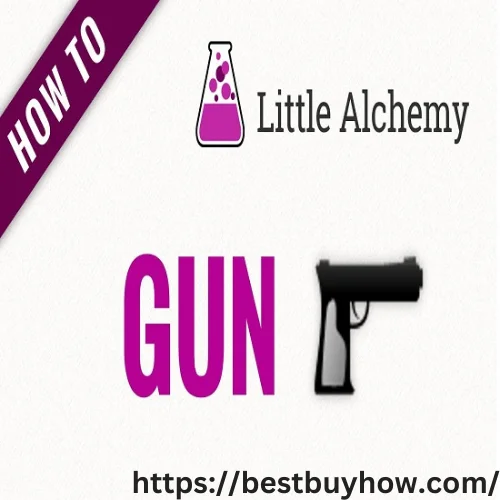A very interesting and engaging online puzzle game called “Little Alchemy” invites its players to explore their hidden creativity and exploration. The game pushes players to discover a wide range of potential inside its virtual environment thanks to its distinctive mechanics of merging diverse pieces. Creating a gun is one of the numerous inventions one might make that frequently causes debate. In the given article, we will go deep into the nuances of “Little Alchemy” and offer an in-depth guide on how to create a gun in the Little Alchemy.
Contents
The “Little Alchemy” Formula:
“Little Alchemy” is not just simply a game; it’s a blank canvas for creative exploration. Users begin with fundamental elements, including planet Earth, the atmosphere, fire, and water, to create new substances and beings. The game is usually designed for players of all ages because of its unique, user-friendly and catchy design and simple mechanics, and its large variety of combinations encourages creativity and problem-solving abilities.
Understanding the Basics:
Understanding “Little Alchemy’s” fundamental principles is crucial before delving into the alchemy process of making a gun. Players may create new elements by placing and dragging existing ones on top of one another. Every effective combination frequently produces a fresh outcome, enhancing the player’s arsenal of weapons. Further interesting features are unlocked as you progress in the game, expanding your options for victory.
Making a Gun:
In “Little Alchemy,” making a gun entails following a precise procedure that can call for some intuition. Here is the equation:
Bullet + Bullet:
By combining two “bullet” components, gamers may create the component of a “gun.”
It’s crucial to emphasize that “Little Alchemy” only uses an abstract image of fusing components to describe how a firearm is built. It is not intended to endorse or promote actual guns. It is important to stress that the construction of a gun in “Little Alchemy” is only an abstract illustration of fusing materials. It’s not meant to support or advertise actual weapons.
Guidelines for Conducting Business in the Virtual World:
Gamers must engage “Little Alchemy” with attention and ethical awareness, just like other interactive mediums. Building numerous goods is possible because of the game’s rules, although this could not transfer into sensible real-world behavior. Viewing the game’s gun use as an exploration of creativity rather than promoting violence is better.
Crafting Beyond: Broadening Horizons:
Why stop there if you’ve mastered the art of making a gun? Countless complex combinations in the “Little Alchemy” universe are just waiting to be explored. Here are some sophisticated mixtures to strive for:
1. Metal + Stone:
Combining metal and stone creates the “blade” component to manufacture items such as swords and knives.
2. Fire + Wood:
The combination of fire and wood creates a “campfire,” a flexible element with various possible uses.
3. Metal + Glass:
The “watch,” a component, which may be used to make timepieces and other temporal creations, is created when metal and glass are combined.
The Alchemy Universe: Exploration:
“Little Alchemy” doesn’t seem about making specific things; it’s also about the excitement of discovery and the delight of adventure. You’ll encounter unexpected results and happy accidents as you explore the game’s depths. This creative game provides a large number of universe of alchemy marvel waiting to be discovered, from the most basic combinations to the most complex invention.
Educational Insights: Play-Based Learning:
“Little Alchemy” is a flexible teaching tool that encourages users to engage in exploration, analytical thinking, and learning via experimenting rather than merely being a whimsical game. Although the game is a frivolous diversion, it contains critical educational ideas that support mental growth and cognitive development.
Fostering Imagination and Creativity:
Players are urged to try things since it forces them to analyze both their combinations’ rational and illogical results. Gamers of every age are inspired to think creatively, fostering creative thinking.
Promoting Solutions to Problems and Creative Thinking:
The game has many combinations, and each one necessitates some level of deductive reasoning and problem-solving. The characteristics of various elements must be analyzed, and players must predict how they could interact.
Encourage the testing of hypotheses:
“Little Alchemy” urges users to create and test hypotheses using combinations, mimicking the scientific method. Players may believe that combining specific parts would result in a given result, and via experimenting, they can confirm their assumptions are accurate.
Applications in the Real World:
Beyond the virtual world, “Little Alchemy” cultivates talents. The scientific method that fuels invention in disciplines like biology, physics, and chemistry is reflected in the game’s emphasis on testing, analytical thinking, and testing of hypotheses. These abilities are helpful in non-scientific problem-solving situations, decision-making, and creative undertakings.
Learning that is cooperative and collaborative:
Although “Little Alchemy” is frequently performed by one person alone, it can also be experienced in a group or cooperative context. Players may collaborate, discuss discoveries, and brainstorm new ideas to find novel combinations. This game’s social component encourages collaboration, dialogue, and idea sharing—a helpful skill that may be applied in various real-world situations.
Conclusion:
“Little Alchemy” is an intellectual field where users are encouraged to let their imaginations run wild, push their mental limits, and enjoy the spirit of exploration. Even if making a gun can be one of the game’s many conceivable combinations, playing with wisdom and a sense of moral duty is essential. The game’s virtual world is an empty canvas for discovery and expression rather than a representation of actual behavior. You’ll discover a wealth of intriguing pairings, perplexing components, and surprises as you delve further into the magical landscape of “Little Alchemy.”
